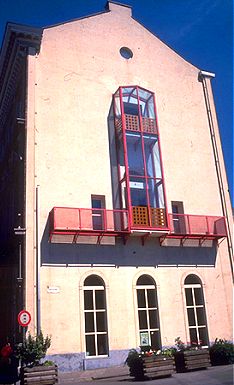
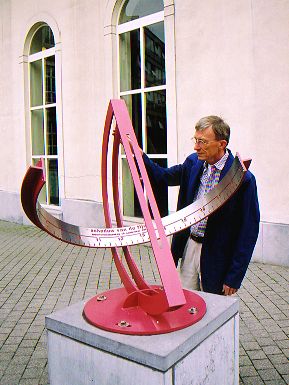
Municipal Museum, Hasselt (Belgium)
The sundials on this page have been designed by Mr. Willy Leenders for the exhibition "Shadow of time. Sundials in Limburg". (Limburg is a province in the Flemish part of Belgium.) It was held from June 17 to September 10, 2000 in the Municipal Stellingwerff-Waerdenhof Museum in Hasselt. It ended at National Heritage Day, which had Time as its theme.
The first two dials can still be admired; the other two had been set up especially for the occasion. The latter were also very cute, so I can't resist showing them here.
Equatorial dial
 |
 |
This dial is located in the little square next to the museum. A risky spot, out in the public domain! It is a very conscious design, though. It does not look particularly heavy; however, in fact it is much sturdier than the usual armillary sphere. Compare this one to the one in Genk, for instance!
The pole-style, usually a rod, has been replaced by a slit in a wide strip of metal. The slit has been beveled inward, so that it allows the sun through until well after 5 pm. And after that the shadow of the strip itself is getting narrow enough for an accurate reading.
The time ring consists of a T-beam, bent to 1 meter (3' 3") diameter. Being open, the ring can be broad and sturdy without blocking the sun around the equinoxes. The time scale is durable and requires little maintenance. Time marks run from 5 to 19 hr local time, which is sufficient in view of the surrounding buildings. The scale has subdivisions per half hour and per quarter.
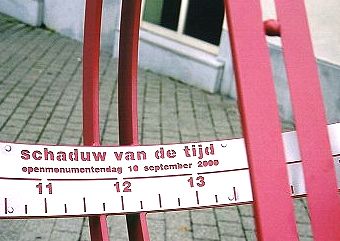 The pole-style has a little ball as an index, welded into the slit. It marks one particular date, when its shadow is exactly bisected by the horizontal line. Here, that date is September 10, which in 2000 was National Heritage Day.
The pole-style has a little ball as an index, welded into the slit. It marks one particular date, when its shadow is exactly bisected by the horizontal line. Here, that date is September 10, which in 2000 was National Heritage Day.
There is of course another day on which the sun has the same declination: April 3. Does that perhaps happen to be a memorable day in Hasselt's stirring history?
An identical armillary sphere by the same designer, but adjusted to another anniversary, can be found in Sint-Martens-Voeren.
Analemmatic dial
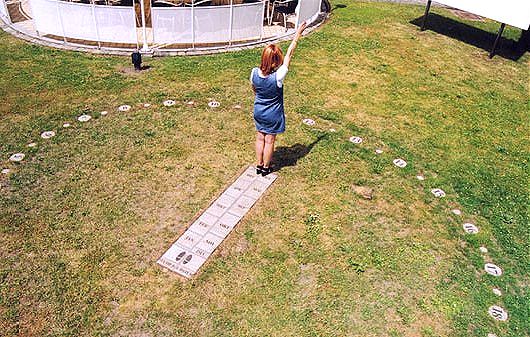
The museum's green became the stage for this analemmatic dial. The major axis is 6 meter (20 ft), an appropriate size. The hour points are ceramic tiles, laid into the grass and running from 4 to 20 hr local time. The half-hours are marked by smaller, blank tiles.
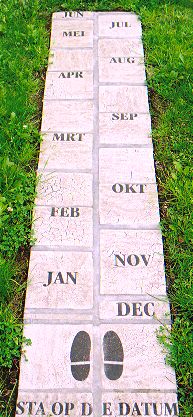 The date line has also been done with ceramic tiles. The 'instructions for use' are concise, yet clear-cut. The text means: "Stand on the date". The foot prints tell you not to stand on the month itself, but on the date line, next to the month.
The date line has also been done with ceramic tiles. The 'instructions for use' are concise, yet clear-cut. The text means: "Stand on the date". The foot prints tell you not to stand on the month itself, but on the date line, next to the month.
The tiles are a work of art by the architect and ceramics artist Gaston Beerden.
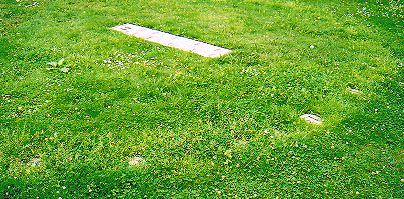 The dial is completely level, lacking any 'sculptural presence'. In this fenced garden, a vertical accent would have been possible. On the other hand, this is easier for the maintenance people. Provided that they drop in with their lawn-mower from time to time, otherwise time will disappear in the shadow...
The dial is completely level, lacking any 'sculptural presence'. In this fenced garden, a vertical accent would have been possible. On the other hand, this is easier for the maintenance people. Provided that they drop in with their lawn-mower from time to time, otherwise time will disappear in the shadow...
Vertical dial
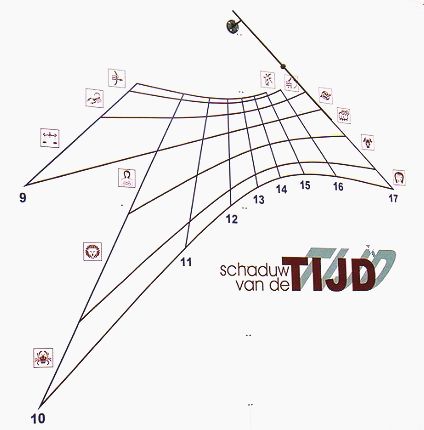
This is a vertical dial with a node on the pole-style, which thus reads time and date. It was painted on a large panel (3 x 3 m, 10 x 10 ft) and served as an eye-catcher for the exhibition. It was given a south-southwest orientation, so as to obtain a non-symmetric, striking line pattern.
The dial face has hour lines from 9 to 17 hr (local time) in brown and date lines for the zodiacal months in blue. The latter were identified by the signs of the zodiac, done in a stylized fashion.
The fact that not all hour lines span the entire date range adds to the intriguing character of the dial face. The mounting of the pole-style, without support at the bottom end, gives the dial a certain lightness.
Virtual vertical dial
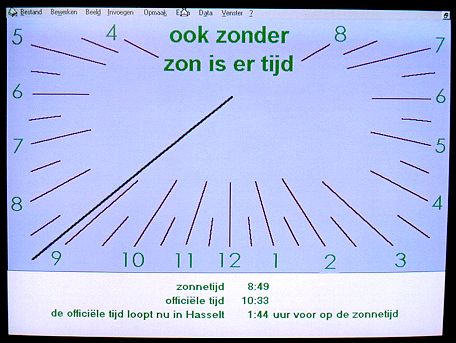
A very neat dial, running on a computer. The motto reads: "time exists even without sunshine"; quite appropriate. It is the only dial here that reads civil time in addition to local time. And I was very surprised to learn from the designer that the dial is running completely in Excel (a spreadsheet program from Microsoft). By now the 'sundial' has been on display at several exhibitions and other events.
Website: Stellingwerff-Waerdenhof Museum, Hasselt
Location: 50.9° N, 5.3° E
Design: Willy Leenders
Inauguration: June 2000